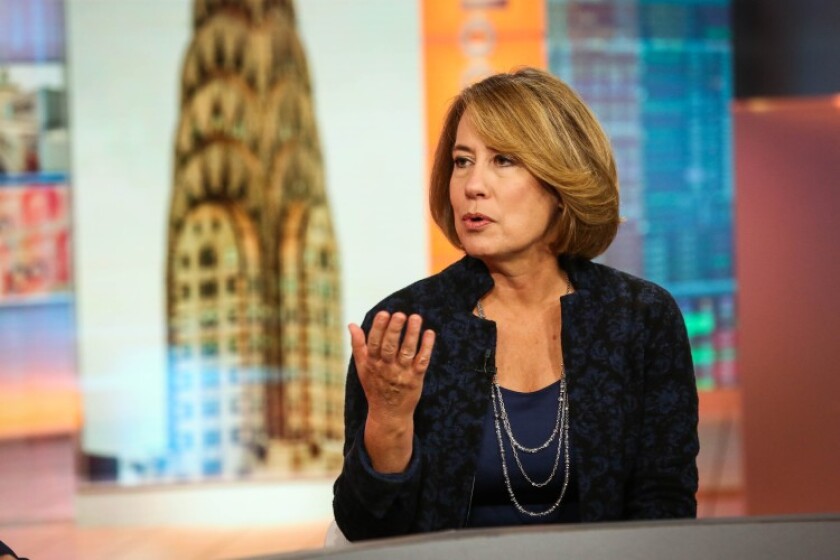Sheila Bair, as head of the Federal Deposit Insurance Corp. during the financial crisis, oversaw the resolution of more than 300 failed banks that went into receivership.
Now, she’ll play a major role in tackling one of the last problems left undone from that era: getting the mortgage giant Fannie Mae out of federal conservatorship.
Bair will become chair of Fannie’s board next week, slightly more than a year after joining the government-sponsored enterprise as a director. The choice was surprising given her past criticisms of the structure of Fannie and Freddie Mac as private companies that enjoyed an implied government backing — which became explicit when the Treasury rescued the companies at a price tag of more than $191 billion in 2008.
She takes the job as the company’s regulator, the Federal Housing Finance Agency, has started the process of untethering Fannie and Freddie from government control.
“She’s going to have a 360-degree perspective on the future of the GSEs that few other people could possibly bring,” said former acting FHFA Director Ed DeMarco, who once worked with Bair at the Treasury Department and now chairs the Housing Policy Council, an industry trade group.

“Someone who ran the FDIC through the financial crisis is going to be well suited to guide the future of Fannie Mae,” former acting FHFA Director Ed DeMarco says of Sheila Bair, who will become chair of Fannie Mae on Nov. 20.
Fannie denied a request for an interview with Bair and declined to comment beyond the announcement last week of her new position. The FHFA also declined to comment.
Bair joined Fannie’s board in August 2019, about four months after Mark Calabria was appointed to run the FHFA. In his first months on the job, Calabria and the Treasury announced an end to a controversial arrangement that prevented Fannie and Freddie from keeping their profits and swept that money into government coffers instead.
Under the new arrangement, the companies are allowed to retain a portion of their earnings in preparation for finally exiting government control. But the details of what a new mortgage system will look like and how — or even when — the two companies will get there have not been ironed out.
Bair’s seat at Fannie is a unique point of contact to work with FHFA on how to navigate the financial and regulatory challenges ahead.
“Both Sheila and Director Calabria are independently minded,” DeMarco said. “But both, I expect, will be very direct and be constructive from both sides in terms of the discussions that will have to go on in order to chart whatever that future path looks like.”
While he was director of financial regulation studies at the conservative think tank Cato Institute, Calabria argued in a 2015 paper for borrowing a page out of the FDIC’s book to resolve the conservatorships of Fannie and Freddie. He even cited Bair’s testimony and her work at the FDIC resolving failing banks and thrifts under a “virtually identical” authority that FHFA has in handling the GSEs.
The big question in housing policy circles is whether the Biden administration would take a new direction.
Calabria’s tenure could be cut short as the Supreme Court is expected to rule on whether a president can replace the FHFA director. Calabria has indicated that many of his plans related to Fannie and Freddie’s conservatorship could take the remainder of his term, which expires in 2024. However, a new FHFA director could cease the effort.
If the high court keeps Calabria in his post, however, a Senate that looks to remain starkly divided after the elections this year may not be able to pass legislation, according to Jaret Seiberg, a policy analyst with Cowen’s Washington Research Group.
The election “takes off the table the ability of Congress to enact legislation that would prevent FHFA from ending the conservatorship,” Seiberg said. “That was a real possibility with a blue sweep.”
Bair’s FDIC tenure was widely praised, but some of her decisions in the heat of the financial crisis were criticized, including the extent to which her agency covered losses incurred by private-equity investors and other acquirers who swept in to take over the operations of failed banks, such as BankUnited in Florida. After taking advantage of its government guarantee, the investor group that ultimately took the reborn bank public earned a $500 million windfall for investors that drew criticism at the time.
However the government ultimately resolves its handling of Fannie and Freddie, the stakes are higher, said Ken Thomas, president of Miami-based Community Development Fund Advisors. Speculators could potentially pocket an even bigger payday if the companies were to exit government control.
Thomas noted that “Fannie Mae is so much bigger and more important to our housing industry and overall economy.”
Fannie needs “some savvy Wall Streeters on … [its] side of the negotiating table when they exit conservatorship” to help anticipate all potential market ramifications, he said.
For her part, Bair has agreed with most GSE watchers that the government needs to maintain a role in ensuring that homeownership is within reach for more Americans. And while she has attacked the “quasi-governmental status” of Fannie and Freddie, she has called on Congress to settle the question outside of administrative actions.
“The goal must be to clarify once and for all which functions should be governmental, and which are strictly subject to the discipline of the marketplace,” Bair said in a 2010 speech.
To DeMarco, Bair brings a past record to Fannie that could reassure skeptics that the company would avoid the risky practices that landed it in conservatorship to begin with.
“Someone who ran the FDIC through the financial crisis is going to be well suited to guide the future of Fannie Mae,” DeMarco said.
